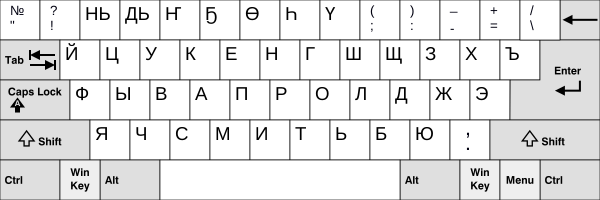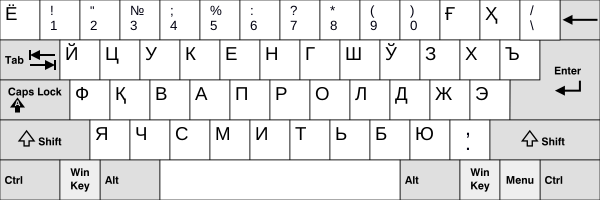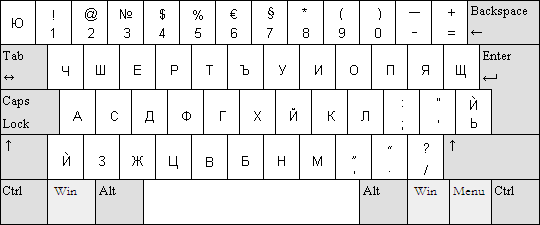JCUKEN: Difference between revisions
| Line 65: | Line 65: | ||
=== Macedonian === |
=== Macedonian === |
||
Also utilizing the Serb-style LJNJERTZ, a single "dead" key is used for input for Macedonian letters «Ѓ ѓ» and «Ќ ќ», as well as the typewritten apostophe (in combination with the «spacebar»): «м. к. á», «К к» → «Ќ ќ», «м. к. á», «space» → «'». |
Also utilizing a modification of the Serb-style LJNJERTZ (LJNJERTDZ), a single "dead" key is used for input for Macedonian letters «Ѓ ѓ» and «Ќ ќ», as well as the typewritten apostophe (in combination with the «spacebar»): «м. к. á», «К к» → «Ќ ќ», «м. к. á», «space» → «'». |
||
[[File:Keyboard layout Macedonian.svg|600px|center]] |
[[File:Keyboard layout Macedonian.svg|600px|center]] |
||
Revision as of 13:57, 13 November 2019
This article needs additional citations for verification. (March 2016) |
JCUKEN (ЙЦУКЕН, also known as YCUKEN, YTsUKEN and JTSUKEN) is the main Cyrillic keyboard layout for the Russian language in computers and typewriters. Earlier in Russia JIUKEN (ЙІУКЕН) layout was the main layout, but it was replaced by JCUKEN when the Russian alphabet reform of 1917 removed the letters Ѣ, І, Ѵ, and Ѳ. The letter Ъ had decreased in usage significantly after the reform.
JCUKEN
PC

Typewriter
Used on typewriters before personal computers. Available in Microsoft Windows as a legacy layout.

JIUKEN
Note that the numbers 1 and 3 does not appear on the layout in this picture.
Other languages
JCUKEN is the basis for many other Cyrillic layouts. For the current moment Microsoft Windows supports the following layouts: Azerbaijani (Cyrillic), Bashkir, Belarusian, Kazakh, Kyrgyz, Mongolian, Tajik, Ukrainian, Uzbek (Cyrillic), Yakut (Sakha).[1] The Belarusian, Ukrainian and Mongolian layouts have been available since Windows 95; Azeri, Kazakh, Kyrgyz, Tatar, Uzbek since Windows XP; Bashkir and Tajik since Windows Vista; Yakut since Windows 7.
Other operating systems such as Linux may have their own additional custom layouts for the same or other languages.
Belarusian

Ukrainian

Tatar
The Russian letters which are rarely used in Tatar are typed with AltGr (right Alt). This layout is also suitable for Kalmyk and Turkmen (Cyrillic) as their alphabets are practically identical to Tatar.

Bashkir

Kazakh

Kyrgyz
Based on the basic Russian one. The additional Kyrgyz letters are typed with AltGr (right Alt).

Yakut

Tajik

Uzbek
The short U substitutes the shcha and the ka with descender substitutes the yery.

Azerbaijani

Mongolian
The Mongolian keyboard uses a modified version of JCUKEN, called FCUZHEN (ФЦУЖЭН), where letters specific to Russian are replaced by letters that see more use in Mongolian.

Other Cyrillic Layouts
Serbian
The Serbian keyboard uses a modified version of JCUKEN, called LJNJETZ (ЉЊЕРТЗ), where letters of Serbian language was used instead of Russian letters. It lacks the yers, Э, and Ё. It is based on the QWERTZ keyboard.

Macedonian
Also utilizing a modification of the Serb-style LJNJERTZ (LJNJERTDZ), a single "dead" key is used for input for Macedonian letters «Ѓ ѓ» and «Ќ ќ», as well as the typewritten apostophe (in combination with the «spacebar»): «м. к. á», «К к» → «Ќ ќ», «м. к. á», «space» → «'».

Bulgarian
Standard Bulgarian keyboard from 2006 (YUEIShShch)

Phonetic Cyrillic keyboard layout for Bulgarian in 2006 (Also known as "ЧШЕРТЪ" ChShert).

Latin JCUKEN
This was the predominant layout on the Soviet-made microcomputers during the 1980s.

See also
References
- ^ "Windows Keyboard Layouts". Microsoft. 2017.
